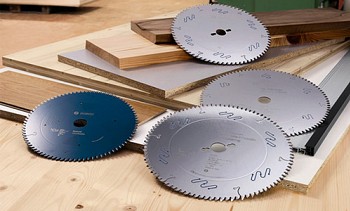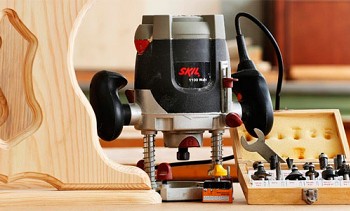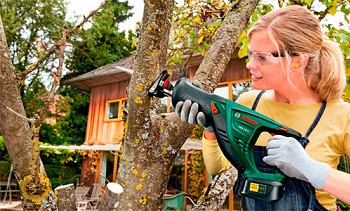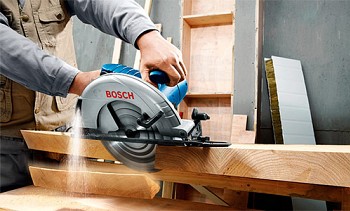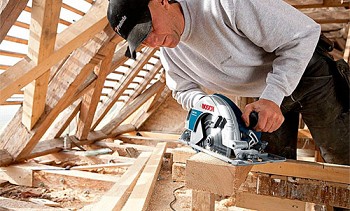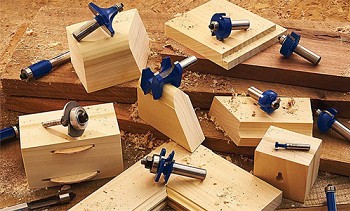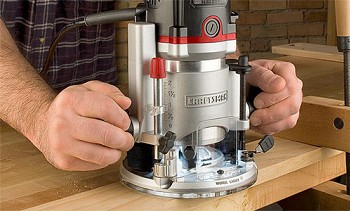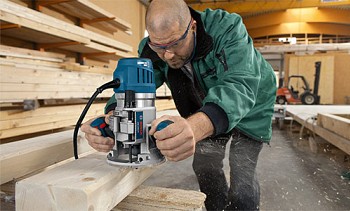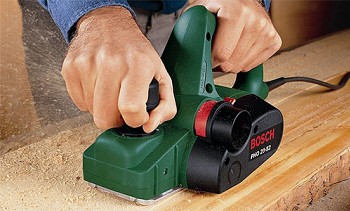How to choose a miter saw for an ordinary consumer, if he has such a need? The most logical solution is to seek the help of a consultant in a specialized store: he will explain everything, tell and even show it. However, to make the conversation with a specialist more substantive, it would be nice to get at least general ideas about the tool before going to the store.
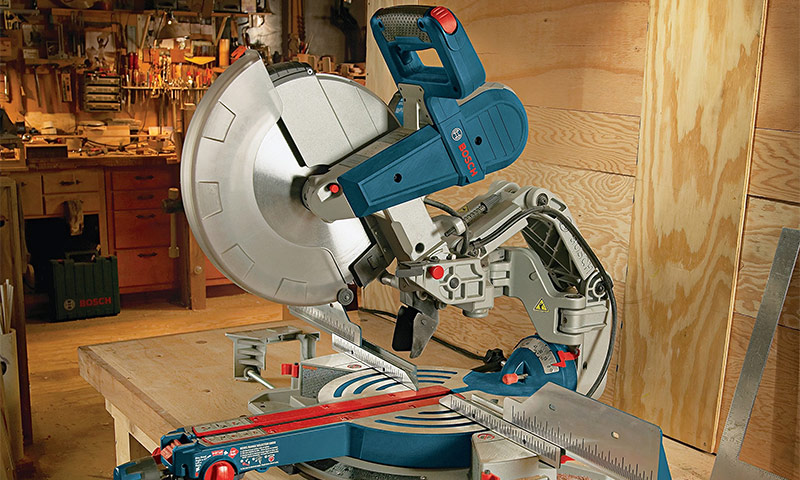
Content:
Purpose of a miter saw
The name "miter" itself serves as an indication of the purpose of this saw - the design of the ends of the workpiece, cutting wood across the fibers. In this, it differs from the closest relative - a circular saw, which is used, as a rule, for a longitudinal cut of a tree.
Modern powerful engines and especially durable saw blades allow trimming to cut not only wood, but also plastic, thin metal profiles and pipes, and composite materials based on wood. For these materials, the concepts of “longitudinal” and “transverse” are very arbitrary: if such terms are used, then we are not talking about the structure of the material, but about the shape of a particular workpiece. Of course, the shape of the workpiece can be very diverse, sometimes without a clearly defined longitudinal axis.


The applicability of the miter saw in one case or another is determined solely by the convenience of supplying a particular workpiece. Thus, the name “miter saw” cannot be considered fully reflecting the potential of this tool, just such a name has historically been fixed to stationary circular saws with a movable cutting unit.
A miter saw can cut material not only at a right angle, but also at an arbitrarily chosen angle, for which it is sometimes called an electric miter box. Moreover, many modern devices allow a change in the angle not only in the horizontal, but also in the vertical plane, that is, it is capable of sawing even at an angle. Using a miter saw, even if necessary, grooves can be selected.

As you can see, the possibilities of this tool are much wider than you might think at first. It is not surprising that trimming is more and more often found in small carpentry, on construction sites, in home workshops. They resort to their help in the manufacture of window frames and door frames, when laying floors (cutting parquet boards, laminate, skirting boards) and other finishing work (sawing lining, various aluminum and plastic profiles), in the manufacture of wooden furniture.
Design and functionality of a miter saw
The trimming device is easy to understand from the figure, which shows the main components of the tool. Everything else is just additions that do not change the principle of work, but only improve functionality and ease of use.

1. Handle with power button.
2. Saw blade.
3. Protective cover.
4. Clamp for fixing the workpiece.
5. Emphasis for preparation.
6. The mechanism for fixing the table at a given angle.
7. Horizontal angle adjustment scale.
8. Table.
9. The mechanism for adjusting the vertical angle.
10. Dust collector.
11. Engine.
12. Carry handle.
The main elements of the miter saw are an electric motor and a saw blade made of high quality heavy-duty steel. The engine, the saw blade and the gearbox connecting them make up the functional unit, here is located the handle with the toggle switch.
The entire block is attached to the base - the bed on which the sawed workpiece is placed. A turntable is fixed on the base, which moves when the cut angle is set, and an emphasis. The beds of relatively expensive devices are made of strong and light aluminum or magnesium alloys, which provides not only the reliability of the base, but also the mobility of the entire tool due to weight reduction.
The function block is connected to the bed via a pivot arm using a spring-loaded hinge. The pivot arm is called a pendulum, and miter saws of this type themselves are called pendulum.
The pendulum provides movement of the working module. To perform the cut, it is necessary to lower the lever down, “drowning” the saw blade in the stationary workpiece (for unhindered sawing in the turntable of the bed there is a slot). This is the easiest miter saw option. As a rule, all modern models are equipped with a mechanism for rotating the desktop along with all mechanisms in a horizontal plane.

Thus, the guides and table elements remain stationary, and the tool itself changes its position in the horizontal plane. The use of such a tool gives more opportunities for trimming.

Combined saws have one more hinge that allows you to rotate the lever relative to the vertical axis (i.e., for such saws, the cutting angle can be changed in two planes). Often, rotation around the horizontal axis is allowed only in one direction - the opposite from the electric drive.

But there are models that allow you to tilt in both directions.

Such technical solutions repeatedly expand the list of tool features. Inclined with respect to the vertical cutting allows you to cut the workpiece whose height is greater than the active radius of the disk.

The cutting width of the miter saw is relatively small, especially when working at an angle or tilt. For example, an average pendulum saw with a 10-inch blade cuts a bar 95 × 95 mm or a board 69 × 135 mm at right angles (when setting any other angles, the allowable workpiece size is reduced). In other words, the miter saw is unsuitable not only for longitudinal cutting, but also for the transverse cutting of wide workpieces.
To increase the width of the cut, the saw is equipped with a traction function. The working block at the trimming with such a function moves not only around the hinge axis, but also along the cutting line along the guide rods, due to which the maximum cut width at an angle of 90 ° increases from 80-180 mm to 280-340 mm. Such tools are called miter saws with broaches or saws with horizontal movement.


In this case, the mechanisms realizing the movement of the saw along the workpiece vary depending on the manufacturer and model of the device.


Varieties and choice of engine for trimming
Most often, the miter saw motor is located to the right of the working disc. However, for some aggregates it is shifted back to maximize the overview of the working surface (regardless of the operator’s hand) and not to create obstacles for inclined cutting - such saws usually have a working head inclined in both directions.
At the end faces, two types of electric motors are installed - asynchronous and collector.
Induction motor
An asynchronous motor is considered more economical, reliable and quiet. It does not have any contacts whatsoever, which means there is nothing to make noise, overheat and fail under the influence of external factors - dust, humidity, vibration. In addition to bearings, there simply is nothing to wear out, therefore, such units can serve without any complaints for decades. However, not all manufacturers of power tools strive to equip their products with such seemingly ideal engines, since they have asynchronous motors and their significant drawback is low power with a fairly large weight.

For example, a 2-kilowatt engine of this type weighs more than 20 kilograms. Agree, it’s quite difficult to move the work unit manually with such an appendage. In addition, when powered by an industrial frequency current, an induction motor, in principle, is not able to reach a speed of more than 2850 rpm. Of course, the use of modern materials and powering the engine with high-frequency current to some extent offset these problems, but do not completely remove them.

Commutator motor
From the point of view of the ratio of dimensions and power, collector motors look much more attractive. With a comparable mass, the torque of the collector motor is several times greater than that of an asynchronous motor. It is capable of delivering up to 5-10 thousand rpm., And the organization of a control system and stabilization of revolutions is much simpler for it.

It is not surprising that despite the drawbacks of collector engines (high noise level, the need for regular maintenance, which consists in replacing the collector brushes), most miter saws are equipped with them.

Brushless motor
However, there is another option based on modern semiconductor technologies - the middle ground between asynchronous and collector types of motor. We are talking about valveless or brushless motors (marked with the letters BL from the English brushless - brushless). In valve motors, the brush-collector assembly is replaced by an electronic unit, characterized by a negligible resistance and a huge switching speed of electronic power valves.


Motors of this type combine all the advantages of asynchronous and commutator motors - high torque and efficiency, quiet operation, unpretentiousness to external factors, long service life, and the absence of the need for regular maintenance. On modern high-quality miter saws, it’s more often that valve motors are installed, because their only drawback - the high price - is more than compensated by so many advantages.
Types of gearboxes, their advantages and disadvantages
The connecting link between the electric motor and the saw blade is a gearbox that transmits and converts engine torque. On miter saws, two types of gearboxes are used - with gear or belt transmission.
Gears gears, providing a rigid bond of shafts, seem more reliable. They do not slip and do not fly off like a belt, and there is nothing to tear. It would seem that manufacturers of miter saws should give preference to such a reliable system. However, in practice, belt transmission on these tools can be seen more often than gear. What is the reason? Gear reliability also has a downside. In the event of an emergency, the gear reducer may fail, and then it will require a complete replacement or serious repair in a specialized service center.
One can also look at the “insecurity" of the belt drive with different eyes. Yes, sometimes the belt flies or even breaks, but to install it in place or replace it with a new one does not require special knowledge and skills - an ordinary user will also cope with this task. In addition, the belt provides some cushioning for radial and axial vibrations, which helps reduce wear on bearings and other engine components. In case of emergency overload of the tool (for example, when the saw blade is jammed), even a well-tensioned belt will slip, which will save metal parts of the motor from destruction. And the noise of a saw with a belt drive produces incomparably less, which is also a rather significant factor.

Miter saw with belt drive.
By the way, some manufacturers (including such reputable ones as Bosch and DeWalt) generally excluded the gear unit in a number of their models by installing a saw blade directly on the motor shaft. This solution also has its pros and cons.On the one hand, the load on the bearings increases, on the other hand, the noise emitted by the tool decreases, the reliability of the structure increases, and maintenance and repair are simplified.
Power and RPM
The power of miter saws can vary from 800 to 2500 W, depending on the model. 1600-1800 W is considered to be the golden mean - tools of precisely such power are most in demand today, because they cope equally well with their task both in home workshops and in small production.
What gives us knowledge of the value of such a parameter as power consumption? Firstly, the correct correlation of the power of the miter saw and the structure of the processed material will help to avoid overloading the tool, which prolongs the time of its active use.
Secondly, the greater the power of the saw, the larger the diameter of the disk that can be installed on it. As an example of this statement, let's compare two miter saws from Bosch. On the PCM 7 model, whose power is 1100 watts, you should select a disk with a diameter of not more than 190 mm. But for the GCM 10 J Professional with a power of 2000 W, a disk with a diameter of 254 mm is suitable. It should be borne in mind that with an increase in the power of the saw and the outer diameter of its blade, the dimensions and weight of the tool increase. So, the first of the examples given as an example weighs 9 kg, and the second is already 14.5 kg.
Another technical feature that you should pay attention to when choosing a miter saw is the number of revolutions of the saw blade. The value of this parameter lies in the range from 3200 to 6000 rpm. A clean and high-quality cut (without chipping coating, splitting wood fibers, etc.) is possible only when working at high speeds. So, for example, when the diameter of the saw blade is 260 mm, its angular speed should be at least 2800 rpm. In expensive professional models, the angular speed, as a rule, is not lower than 4000-5000 rpm. even with large disc diameters. A number of manufacturers offer miter saws, the number of revolutions of which can be adjusted depending on the type of work being performed at the moment.
Additional devices
Almost all modern models of miter saws have one or another additional devices and functions aimed at facilitating work and increasing safety. The future user of the instrument will have to figure out for himself at the stage of selection which of them are really necessary for solving the typical tasks that he has and which will be an unjustified waste of money.
1. The dust removal system consists of a nozzle and a dust bag or an industrial vacuum cleaner hose connected to it. The second option is preferable, because it allows you to more effectively capture the fine dust of the processed material generated by performing an accurate cut when the saw is operating at high speeds and / or discs with an increased number of teeth. The dust extraction system should not be considered as an additional, optional function, even if you are faced with the task of choosing a miter saw for the house, i.e. low-intensity episodic work on it is supposed. Working without a dust removal system, you risk not only the safety of the equipment available in the workshop (and primarily the saw itself), but also your own health.

2. The protective cover completely covers the working disk until it is immersed in the material being cut, which significantly reduces the risk of accidents when working with a miter saw.

3. Limiting the depth of cut is used to perform groove sampling or trimming profiles.

4. The laser "draws" a guide line on the workpiece in the place where the saw makes a cut. The presence of this option increases the accuracy of the cut (especially when sawing at angles other than 90 degrees), facilitates work, and reduces the time for pre-treatment.

5. Illumination of the working area is useful when working in workshops or workshops with insufficient general lighting.

6. A soft start provides a gradual set of revolutions by the engine when it is turned on, thereby preventing a “jerk” of the tool at start-up, reducing the risk of the saw failing due to a sharp surge in current and the likelihood of jamming of the tool at the beginning of work.
7. Automatic shutdown when the saw blade is jammed is another useful feature aimed at improving safety when working with a miter saw.
8. Adjusting the number of revolutions allows you to vary the cutting speed. Most miter saw models do not have this feature. However, it allows you to better adjust the sawing process to the characteristics of the processed material. It is recommended for those who intend to work not only with wood, but with various materials based on it, plastic, plexiglass, etc.
9. Constant rpm support during increased load. In the presence of such a function, the engine speed does not fall under strong pressure, since the electronics make corrections to the speed. As a result, the cut is neat and clean.
Saw blades
Often, beginning masters who do not have sufficient knowledge, but who have a great desire to acquire a new tool, ask the question: "How to choose a miter saw for wood?" A similar question is not entirely correct. Any trimming will cope with the sawing of wood, because for this it is created. But how much you will like the result of the work depends not so much on the tool itself, but on the equipment installed on it - the saw blade.

1. Technological slots.
2. Landing diameter.
3. Outside diameter.
4. The value of the outer diameter.
5. Maximum disk rotation speed.
6. Trimming disc for 96 teeth.
7. Disc thickness value.
8. The value of the bore diameter.
Outer and rim diameter
The main parameters when choosing saw blades, which you should pay attention to first of all, are the dimensions of the outer and mounting diameters. Most of the miter saws manufactured today are designed to work with disks whose landing diameter is 30 mm.
There are exceptions with a deviation both in that and in the other direction, but there are relatively few of them. The outer diameter of the saw blades varies significantly wider. The most popular are standard disks of 10 inches and 12 inches. It should be borne in mind that under 12 inches can mean both 300 mm and 305 mm, and under 10 inches and 250, and 255 and even 260 mm, and there are different interpretations even from the same manufacturer. Disks of smaller (185-216 mm) and larger (up to 360 mm) diameters are less common, since lesser equipment is produced.

Increasing the diameter of the saw blade allows you to process workpieces with a larger cross section, while increasing the productivity of the tool and the quality of the cut at the same speed. However, larger discs also require higher torque, which means an additional power reserve. However, it will not be possible to use saw blades whose outer diameter exceeds that specified in the instrument passport: the trimming design simply will not allow the installation of such equipment that will save especially careless users from dangerous experiments. It is possible to install a smaller disk, but this is not recommended. This will lead not only to a loss in the effective radius and productivity of the tool, but also to a decrease in the calculated dynamic resistance, as a result of which the engine, in the absence of stabilization of revolutions, can “go into spacing”.
Technical characteristics of saw blades
The coincidence of the size of the seat and a suitable outer diameter of the disk is a necessary but insufficient condition for its use to perform any operation on the miter saw - there are many other nuances that also need to be taken into account.
In addition to the outer and inner diameters, the discs may differ in the following characteristics:
- material type;
- thickness;
- number and size of teeth;
- tooth shape and angle of inclination;
- permissible speed.
Material type. By the type of material from which the disks are made, they are all divided into monolithic and carbide. Monolithic are made of high carbon or high speed steel. They are quickly dull, but subject to sharpening, and you can do this yourself. Carbide wheels made of hard tool steel have hard alloy brazed tips (in most cases, tungsten carbide). Such disks, despite the high price, have earned popularity among specialists due to their reliability and long service life.

Monolithic and carbide disc.
Disc thickness. The thickness of the saw blade determines the width of the cut and the mode of operation. Thin disks are often used for cutting valuable wood species, they economically consume material, but are less durable and durable. Thick disks have a large resource, but they perform a coarser cut.
Number and size of teeth. The number of teeth on the disk, which can vary from 8-10 to 80-90, affects two factors - the speed and quality of the cut. The more teeth the disc has, the cleaner the cut will be, but the speed will be lower. The same relationship exists with the size of the teeth: small ones for a slow and accurate cut, large ones for a quick but rough one.
The shape of the teeth and their angle. The shape of the teeth determines the applicability of this disk for a particular operation, sawing a particular material. For example, a trapezoidal tooth is suitable for cutting wood, chipboard, plastic, non-ferrous metals. Concave is intended for cutting materials with a single-layer or two-layer coating, such as a laminate, as well as abrasive materials. A removable tooth (the tips of the teeth are chamfered alternately to the left or to the right) provides a clean cut of wood, plywood, MDF, etc.
The teeth of the saw blade can differ not only in their shape, but also in the angle of inclination, i.e., the deviation of the surface of the cutting edge from the radius of the saw blade. Drives with a positive slope (from 5 ° to 20 °) are generally recommended for longitudinal saws of wood and wood-containing materials. They can be used on miter saws, but the cut will turn out to be rough, albeit quick, and the increase in productivity and the drop in quality are proportional to the increase in the angle of inclination of the teeth.

Positive tilt disc teeth.
A negative slope (–5 °) is ideal for trimming: the process slows down, but the cut is clean. A zero angle of inclination of the teeth indicates that this disk is designed to work with solid materials, such as metals.

The teeth of the disk with a negative inclination.
Disk speed. Permissible speed can vary from 3800 to 23800 rpm. It should be remembered that the number of revolutions indicated on the disk must be greater than the rotational speed of the miter saw shaft, otherwise the disk may simply break during operation. Your safety directly depends on compliance with this rule!
The basic information about the disk - the landing and outer diameter, thickness, number of teeth, purpose, maximum permissible number of revolutions - can be found in the markings applied to the canvas. However, even with this information, it is not always easy to find what you need among a huge variety of disks on store shelves, so do not neglect the advice of specialists. These are not common among store sellers - it is better to seek help from a person who has real experience working with similar equipment.
If a professional who could help you with the choice wasn’t near, you should follow two simple rules: first, use only the blades that are recommended for this model of the miter saw, and secondly, cut only the material for which it is intended given disk.
Today, the market is full of so-called "universal" discs, which, according to advertising, can be installed on any type of instrument and equally well cope with various materials and tasks.Alas, in this world there is nothing universal at all, but a universal tool for cutting and sawing power tools. Otherwise, manufacturers would not spend time and a lot of money on calculations, testing and production. Remember that the “left” disk may simply not withstand the loads created by the tool. And this means that the user who decides to use the equipment not recommended by the manufacturer risks both expensive equipment and, most importantly, his health.

